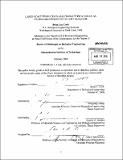Large-scale production and characterization of an engineered human olfactory receptor
Author(s)
Cook, Brian Lee
DownloadFull printable version (17.47Mb)
Alternative title
Engineered human olfactory receptor
Other Contributors
Massachusetts Institute of Technology. Dept. of Biological Engineering.
Advisor
Shuguang Zhang and Angela M. Belcher.
Terms of use
Metadata
Show full item recordAbstract
Animal noses have evolved the ability to rapidly detect a seemingly infinite array of odors at minute concentrations. The basis of this sensitivity are the olfactory (smell) receptors - a large, highly related class of sensory G-protein coupled receptors that function together combinatorially to allow discrimination between a wide range of volatile and soluble molecules. However, the structural and functional mechanisms of these amazing receptors are not currently known. In order to begin to investigate the molecular mechanism(s) of olfaction, I have developed a mammalian expression system for the large-scale production and purification of functional olfactory receptor (OR) proteins in milligram quantities. Expressed OR genes were fabricated from scratch using PCR-based gene synthesis, which facilitated codon optimization and attachment of different affinity tags for purification. Established methods for the production and purification of rhodopsin were adapted to olfactory receptors through extensive optimization (including a full-spectrum screening of over 45 detergents). Key to the efficient extraction and solubilization of olfactory receptors tested is the use of novel zwitter-ionic fos-choline detergents. Following initial experiments on the inducible expression of a human olfactory receptor (hOR17-4) in adherent HEK293S cell cultures, the system was successfully scaled up using a suspension bioreactor. Large-scale culture allowed the purification of >10 milligrams of hOR17-4 monomer at >90%, which was suitable for subsequent X-ray crystallization screening trials. The purified protein was also characterized using several spectroscopic methods and shown to possess the correct secondary structure and several predicted post-translational modifications. To assay the functionality of purified (nonmembrane- bound) hOR17-4, we successfully developed an in vitro assay method using surface plasmon resonance (SPR) to demonstrate that the receptor retains functional selectivity in binding specific odorant ligands in a concentration-dependent manner. The application of these techniques to other olfactory receptors already shows promise and could lead to a generalized method for obtaining large quantities of any olfactory receptor in a rapid and simple manner. Such methods could prove extremely useful in elucidating the structural and functional mechanism(s) of olfactory receptors and in their integration into OR-based biosensor devices.
Description
Thesis (Ph. D.)--Massachusetts Institute of Technology, Dept. of Biological Engineering, February 2009. Cataloged from PDF version of thesis. Includes bibliographical references.
Date issued
2009Department
Massachusetts Institute of Technology. Department of Biological EngineeringPublisher
Massachusetts Institute of Technology
Keywords
Biological Engineering.